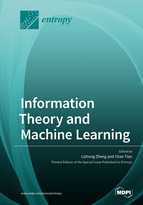Information Theory and Machine Learning
A special issue of Entropy (ISSN 1099-4300). This special issue belongs to the section "Information Theory, Probability and Statistics".
Deadline for manuscript submissions: closed (28 February 2022) | Viewed by 39141
Special Issue Editors
Interests: learning theory; deep learning; information geometry; statistical inference; multi-terminal information theory
Interests: a computational approach to information theoretic converses; coding for distributed data storage; joint source-channel coding; an approximate approach to network information theory lossy multiuser source coding problems
Special Issue Information
Dear Colleagues,
There are a number of significant steps in the development of machine learning that benefit from information theoretic analysis, as well as the insights into information processing that it brings. While we expect information theory to play an even more significant role in the next wave of growth in machine learning and artificial intelligence, we also recognize the new challenges in this task. There are indeed a set of lofty goals, where we hope to have a holistic view of data processing, to work with high-dimensional data and inaccurate statistical models, to incorporate domain knowledge, to provide performance guarantees, robustness, security, and fairness, to reduce the use of computational resources, to generate reusable and interpretable learning results, etc. Correspondingly, in theoretical studies, we shall need new formulations, new mathematical tools, new analysis techniques, and maybe even new metrics to evaluate the guidance and insights offered by theoretical studies.
The goal of this Special Issue is to collect new results in using information theoretic thinking to solve machine learning problems. We are also interested in papers presenting new methods and new concepts, even if some of these ideas might not have been fully developed, or might not have the most compelling set of supporting experimental results.
Some of the topics of interest are listed below:
- Understanding gradient descent and general iterative algorithms;
- Sample complexity and generalization errors;
- Utilizing knowledge of data structure in learning;
- Distributed learning, communication-aware learning algorithms;
- Transfer learning;
- Multimodal learning and information fusion;
- Information theoretic approaches in active and reinforcement learning;
- Representation learning and its information theoretic interpretation;
- Method and theory for model compression.
Prof. Dr. Lizhong Zheng
Prof. Dr. Chao Tian
Guest Editors
Manuscript Submission Information
Manuscripts should be submitted online at www.mdpi.com by registering and logging in to this website. Once you are registered, click here to go to the submission form. Manuscripts can be submitted until the deadline. All submissions that pass pre-check are peer-reviewed. Accepted papers will be published continuously in the journal (as soon as accepted) and will be listed together on the special issue website. Research articles, review articles as well as short communications are invited. For planned papers, a title and short abstract (about 100 words) can be sent to the Editorial Office for announcement on this website.
Submitted manuscripts should not have been published previously, nor be under consideration for publication elsewhere (except conference proceedings papers). All manuscripts are thoroughly refereed through a single-blind peer-review process. A guide for authors and other relevant information for submission of manuscripts is available on the Instructions for Authors page. Entropy is an international peer-reviewed open access monthly journal published by MDPI.
Please visit the Instructions for Authors page before submitting a manuscript. The Article Processing Charge (APC) for publication in this open access journal is 2600 CHF (Swiss Francs). Submitted papers should be well formatted and use good English. Authors may use MDPI's English editing service prior to publication or during author revisions.








